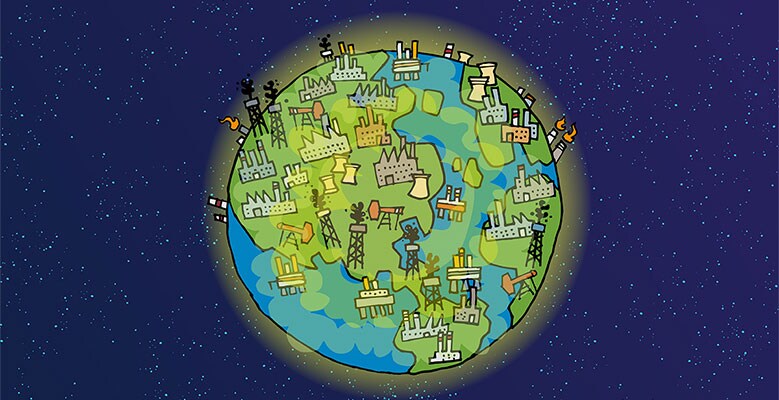
Climate change is creeping closer and closer to our daily lives. Even our most beloved ice cream flavors are under threat, and that’s a serious problem. Before any more icebergs melt or delicious ice cream ingredients see their habitats vanish, let’s take a look at the things that are causing the most pollution and thus contributing the most to global climate change:
-
Cars: Beep, Beep, Here Comes Climate Change
In 2014, it was estimated that there were 1.2 billion motor vehicles on the road globally. Today that number is likely even higher. Cars are everywhere, and so is their pollution (you know, the stuff that comes out the exhaust pipe). Sure, many people have made the switch to electric or hybrid cars, but they’re still in the extreme minority worldwide.
For some people, switching to public transportation, carpooling, or bicycling to work and beyond can be an easy way to reduce your carbon footprint. If the car’s your only option, though, try driving more smoothly to reduce fuel consumption.
-
Buildings: Heating & Cooling Means A Whole Lotta Heating
Across Europe, heating and cooling is the biggest single energy user, and 75% of that energy comes from fossil fuels. A remarkable amount of that energy is wasted on poorly-insulated homes with draughty windows and doors. So a bit of draught busting at home can make a big difference in saving energy.
In sunnier climes, air conditioning chews through a whole lot of electricity, too. In 2015, the US used as much electricity for air conditioning as the entire continent of Africa used for all their energy needs combined. And as people in developing countries get richer, energy demand from air conditioning is expected to triple in the next thirty years.
-
Planes: Global Temps Are Taking Off
If air travel were a country, it would be the seventh biggest emitter in the world. Globally, it’s the fastest growing source of carbon emissions.
If you love travelling, cutting down on flying is one of the most important things you can do to cut your carbon footprint. Avoiding a return transatlantic flight saves more carbon than choosing to live car-free for an entire year. There are plenty of amazing destinations to explore by train or coach all around Europe. Grab a tub of your favourite ice cream flavour and go have an adventure!
-
Electricity: Where It Comes From Matters
Making electricity using fossil fuels really hurts the climate. Of the ten biggest polluting companies in Europe, nine are coal power stations. So despite the fact that 40% of Germany’s electricity comes from renewables, another 40% coming from coal blows their emissions sky high.
Of course, clean power is on the rise. In Scotland and Denmark, blustery days often mean 100% wind power, and thanks to wind and hydro power, Portugal produced more renewable electricity than they needed for the whole of March. Switching to a green energy supplier is one way you can support renewable energy infrastructure.
-
Industry: What We Make Makes The World Heat Up
From mining to factories to construction, “industry” is a broad term. Obviously factories and machines need power, but plenty of industries that you may not even think about burn fossil fuels to make their products. For example, turning iron into steel uses masses of energy to get rid of the impurities. And cement, the key ingredient in concrete, makes up 8% of the world’s carbon emissions because to make it, you have to heat the ingredients in a 1400°C kiln. Now that takes a lot of energy!
-
Agriculture & Land: The Things We Eat Eat Up Our Climate
One of the weapons fighting climate change is the natural world itself. Forests and peat bogs naturally suck up the climate-change-wreaking carbon we produce. But use that land for grazing animals or growing crops, and those emissions have nowhere to go but up.
Obviously we all need to eat — but as demand for food goes up around the world along with our ever-rising global population, so do emissions from farming. Burping cows spew out methane, and other nasty gases seep out from manure and fertilisers. Producing a kilo of meat or dairy creates more emissions and uses raw materials and water than any other food.
So when you’re thinking about what to have for dinner tonight, spare a thought for the planet and consider swapping that meat feast pizza for something more plant-based.
This blog post was written by our climate activist partners at 10:10 Climate Action.
Sweeten Up Your Inbox!
Subscribe now and we'll make sure you get the inside scoop on Ben & Jerry's fun and flavours! It's like dessert for your inbox, and you're going to want seconds.

